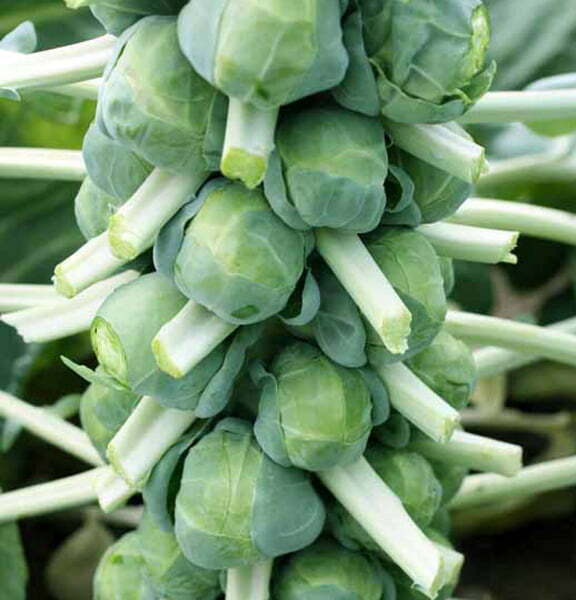Brussels Sprouts [ Brassica oleracea ] you either love them or hate them, I love them! What Christmas dinner table would be complete without them! They appeared as a sport from a cabbage plant and are a very hardy winter vegetable that can stand our coldest winters here in the UK. By choosing early and late varieties, you can have fresh sprouts from late summer right through the winter.
Soil Preparation.
Sprouts like a rich firm soil so add lots of well rotted manure or garden compost in the winter and let the soil settle before planting. Choose a sunny, sheltered site protected from strong winds. As all brassicas like a slightly alkaline soil, add a dressing of lime before planting. If in doubt you can do a soil test.
Sowing.
Traditionally sprouts are sown into a nursery bed. An early sowing can be made in a coldframe or under cloches. Work the soil to a fine tilth, then sow thinly a half inch deep in short rows. When the seedlings are 2 – 3 inches high, thin to 3 inches apart. Seeds can also be sown and raised singularly in pots or modules, this method is particularly useful if your plot has clubroot as it gives the plants a headstart.
Planting and Growing.
When the young plants are about 4 – 6 inches high and have 6 to 7 leaves, they can be transplanted into their final growing positions. Space the sprout plants about 2 feet apart and allow about 2.5 feet between rows. Water the plants well after planting. Firm the soil around the base really well, this helps to make the young sprouts grow nice and tight. Water the plants well in dry weather and feeding with a high nitrogen fertiliser like pelleted chicken manure in summer will give them a boost. If your site is exposed or windy, short canes can be tied to the sprout stems for support. Earthing the soil up around the base of the plants in late summer will give added support.
Harvesting.
Early sowings can be harvested from August and if you grow earlies, mid season and lates, you can harvest sprouts right through the winter. Start harvesting by picking the lower sprouts on the stems first. These lower sprouts are the first to form. Pick when about the size of a walnut. The flavour is said to improve after they get frosted. When all the sprouts have been harvested, the sprout tops and leaves can be eaten like cabbage.
Varieties. Check out seeds at the seedparade shop.
Earlies: Early Half Tall, a quick growing early variety.
Mid season: Darkmar, good for Christmas sprouts.
Mid to Late: Evesham Special, a good all rounder, or Groninger.
Try the unusual red variety Red Bull.
Problems.
Clubroot.
A disease that causes the roots to become swollen and distorted, this can cause the plants to yellow and growth to become stunted. In severe cases the plant may die. Try growing a clubroot resistant variety and grow in pots of sterile compost. This allows a plant with a large rootball to be planted out, giving the plant the best chance of growing well.
Birds and Butterflies.
Both of these will eat the leaves, reducing the plants vigor and cropping. Cover the plants with a physical barrier like fine netting or mesh, or use a homemade garlic spray.














